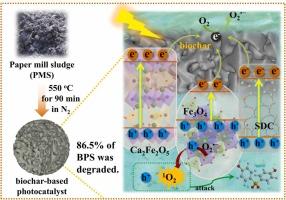以造纸厂污泥为原料制备具有多异质结构和适当结构缺陷的高效光催化剂,用于光降解双酚s
IF 6.3
2区 材料科学
Q2 CHEMISTRY, PHYSICAL
引用次数: 0
摘要
探索具有制备简单经济、电荷分离效率高、易于放大等优点的光催化剂对于光催化降解新兴污染物具有重要意义。在这一过程中,以造纸厂污泥(PMS)为原料,通过简单的一步热解制备了生物炭基光催化剂。值得注意的是,热解温度是调节材料相组成和结构缺陷(包括表面氧空位和碳缺陷)的关键因素,从而进一步影响带结构、界面光激发电荷的迁移以及e−/h+对分离的效率。具体来说,在550℃下热解的pms衍生生物炭(SBC550)对双酚S (BPS)表现出优异的光催化降解效率,在180分钟内降解了86.5%的BPS。SBC550的最佳性能归功于其巧妙而合适的多异质结构的构建,其中Ca2Fe2O5/Fe3O4包埋在S掺杂石墨碳(SDC)中。电子转移的增强源于适当的结构缺陷以及多孔碳质衬底所赋予的促进电子穿梭效应。此外,通过HR-MS测试和DFT计算,确定了BPS的主要活性氧为1O2和h+,并合理推导了BPS对苯氧基的降解途径和1O2的亲电环加成。总的来说,这项工作为PMS在光催化策略领域的应用提供了重要的新见解,以应对新出现的污染物的挑战。本文章由计算机程序翻译,如有差异,请以英文原文为准。

Efficient photocatalyst with multi-heterostructures and appropriate structural defects simply from paper mill sludge for photodegradation of bisphenol-S
Exploring photocatalysts with the merits of simple and economical preparation, excellent efficiency of charge separation and ease of scaling up holds paramount importance for photocatalytic degradation of emerging contaminants (ECs). In this pursuit, a biochar-based photocatalyst was fabricated from paper mill sludge (PMS) via a straightforward one-step pyrolysis. Notably, the pyrolysis temperature emerged as a pivotal factor that modulated the phase composition and structural defects (including surface oxygen vacancy and carbon defects) of materials, thus further influencing the band structure, the migration of interfacial photoexcited charges and the efficaciousness of the separation of e−/h+ pairs. Specifically, the PMS-derived biochar pyrolyzed at 550 °C (SBC550) exhibited excellent photocatalytic degradation efficiency towards bisphenol S (BPS) with 86.5 % of BPS being degraded within 180 min. The optimum performance of SBC550 was attributed to the ingenious and fitting construction of a multi-heterostructure comprising Ca2Fe2O5/Fe3O4 embedded within S-doped graphitic carbon (SDC), enhanced electron transfer stemmed from appropriate structural defects as well as the facilitative electron shuttle effect endowed by the porous carbonaceous substrate. Besides, 1O2 and h+ were confirmed to be the main ROS attributed to the elimination of BPS and its degradation routes of phenoxy radical and electrophilic cycloaddition of 1O2 were reasonably deduced based on the HR-MS tests and DFT calculations. Collectively, this work provided crucial and new insights into the utilization of PMS in the domain of photocatalytic strategy for tackling the challenge of emerging pollutants.
求助全文
通过发布文献求助,成功后即可免费获取论文全文。
去求助
来源期刊

Journal of Alloys and Compounds
工程技术-材料科学:综合
CiteScore
11.10
自引率
14.50%
发文量
5146
审稿时长
67 days
期刊介绍:
The Journal of Alloys and Compounds is intended to serve as an international medium for the publication of work on solid materials comprising compounds as well as alloys. Its great strength lies in the diversity of discipline which it encompasses, drawing together results from materials science, solid-state chemistry and physics.
 求助内容:
求助内容: 应助结果提醒方式:
应助结果提醒方式:


